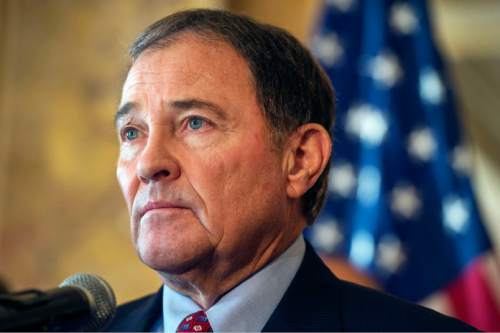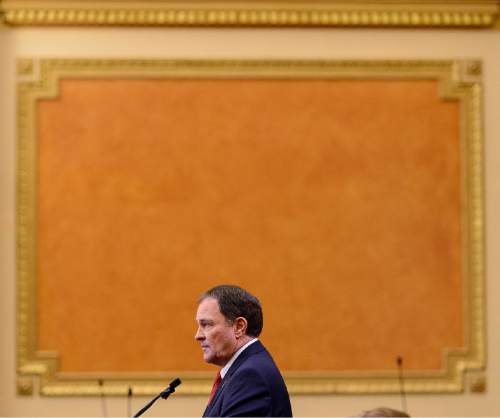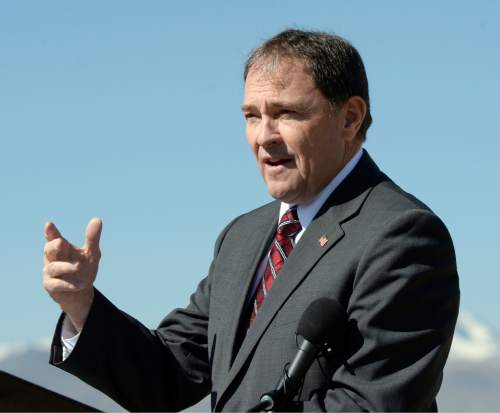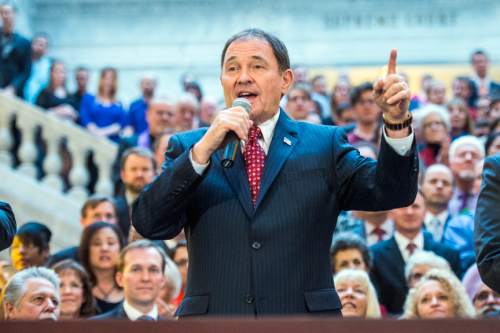This is an archived article that was published on sltrib.com in 2015, and information in the article may be outdated. It is provided only for personal research purposes and may not be reprinted.
Taking the helm as chairman of the National Governors Association on Saturday, Gov. Gary Herbert said he wants the organization to highlight innovative problem-solving by states that can serve as models for others — specifically citing Utah's efforts on Medicaid expansion as an example.
"You've seen what we're doing with health care reform," Herbert said in an interview previewing his priorities. "What we have, I think, is better than Medicaid expansion. If we get this thing approved, I think you'll find it's better for taxpayers and a better solution than Medicaid expansion."
Herbert met briefly with U.S. Health and Human Services Secretary Sylvia Burwell on Saturday at the National Governors Association meetings to discuss a "conceptual framework" that the governor and legislative leaders announced earlier this month.
The two did not drill down into specifics of that framework.
"It was just very broad in scope," Herbert spokesman Jon Cox said. "She's very anxious to get that proposal and work it through with us, and we're anxious, too, but we still have to work through some of that."
Cox said the intent is for state lawmakers and the governor to agree on a plan and pass it through the Legislature before they seek waivers from the federal government, then try to negotiate with the Obama administration from a unified front.
Burwell is due in Salt Lake City next month, and there are some discussions about a meeting at that time with Herbert and the so-called Gang of Six, Utah leaders who have been negotiating the Medicaid plan.
Utah's framework to expand Medicaid under the Affordable Care Act, commonly called Obamacare, relies on hospitals, doctors and the pharmaceutical industry — both pharmacists and drugmakers — to pay the state's portion of the cost of covering as many as 126,500 low-income Utahns.
In the initial years, the federal government pays nearly all the costs for the expanded coverage, with the state picking up more of the burden over time, ultimately paying for 10 percent of the expanded program.
Because the health care providers stand to reap the benefits from the expanded coverage, Herbert said it makes sense to have them pay for more of the tab.
For example, the governor said, University Hospital provides $125 million in care each year for which it never receives payment. Eighty percent of those costs would be covered under the expanded Medicaid, so it is fitting to ask the hospital to pay part of the state's tab for the program.
"The end result is they have a net gain," Herbert said. "Everyone will have a net gain, as far as the practitioners who are providing the services and will pay for the costs [the state has] to come up with to provide the 10 percent match."
All told, he said, the doctors, hospitals and pharmaceutical industry stand to gain between $150 million and $200 million. The 10 percent share the state would be expected to cover comes to about $78 million, meaning it would still come out ahead and tens of thousands of Utahns making less than 138 percent of the poverty level — about $33,000 for a family of four — would get health care.
Those expenses should not be passed on to other consumers — as they are now — he said, so health care costs for the average Utahn should not increase. Some have argued that they will go up, said Herbert. "Mainly [those] people who don't want to understand that this is not going to be passed on in higher health care costs."
Utah's Republican governor also wants to discuss with the feds a work requirement that he said is important to the plan.
"If we can get the concept … we'll work out the details," he said. "I think we're very close. I don't see anything on the table right now that we're proposing or will propose that will be a deal-breaker. … [But] I don't want to jinx it until we get it done."
Medicaid expansion is just one area in which state innovations can serve as models for other states, said Herbert, who plans to compile a book of best practices and new ideas that have worked in states across the country.
"Let's look to the states," Herbert said. "Let's quit looking to Washington, D.C., for these solutions to whatever challenges we face out there. We ought to have 50 laboratories of democracy, innovators creating new ways to do things."
Herbert said states, including Utah, have been leaders in helping students pay for college, preserving sage grouse and other endangered-species habitat, and managing public lands.
"It's a good principle, a good concept, to look to the states for state solutions and the unique challenges the states face," Herbert said. "We ask too much out of Washington, D.C., and it's hard for them to deliver what we're asking. It's large, it's cumbersome, there's dysfunctionality, and what you end up with is a one-size-fits-all solution which works for the few, but doesn't work for the many."
With Herbert becoming NGA chairman, Utah will enjoy a rare trifecta: Salt Lake City Mayor Ralph Becker is president of the National League of Cities and Sen. Curt Bramble, R-Provo, is due to become president of the National Conference of State Legislatures on Aug. 6.
Bramble said he met with Herbert last week to discuss the governor's idea of focusing on state innovations.
"I'm excited about his initiative because it literally coincides very nicely with the mission of NCSL," Bramble said. "Governors find it very difficult to do anything without legislative support, and legislators can't do anything without the governor's support. No matter what state, we're pretty much joined at the hip. What's exciting [is] that we may be able to find some synergism between NCSL and NGA."
gehrke@sltrib.com Twitter: @RobertGehrke









